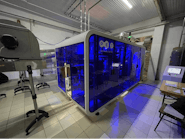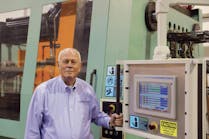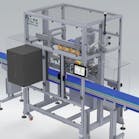Wittmann Battenfeld has added three new models to its Primus series of three-axis servomotor-controlled robots, designed for sprue picking and pick-and-place applications.
The new Primus 10, the smallest unit in the product line, has a payload capacity of 3.3 pounds. The vertical Y-axis has a standard stroke of either 1.9 feet, 2.6 feet or 3.2 feet, while the horizontal stroke ranges from 3.2 to 6.5 feet. The demolding stroke is about 1.44 feet, said Jason Long, national sales manager, robots and automation.
The company also added the Primus 26 and Primus 26T (telescoping) robots. Both Primus 26 models can handle payloads up to 22 pounds. The vertical axis has a stroke up to about 4.6 feet and the horizontal stroke is up to 19.7 feet. The Primus 26 models, the largest in the line, are suited for use with injection presses with 400 tons of clamping force or more, Long said.
The new models join the Primus 16 and Primus 14 robots, which launched in 2017. The Primus 16 features a maximum payload of 11 pounds and a horizontal stroke of 4.9 feet or 8.2 feet, a vertical axis with a stroke of 2.5 feet, 3.3 feet or 3.9 feet, and a demolding stroke of 1.38 feet or 2 feet. The Primus 14 is designed for use with presses that have clamping forces ranging from 50 to 150 tons. It has a maximum payload of 4.4 pounds, with a horizontal axis stroke from about 3 feet to 6.5 feet, a vertical axis stroke of up to 3.2 feet and a demolding stroke of 1.4 feet.
Primus robots incorporate several standard features, functions and programs for operating efficiency. These include a drive system with 400-watt power output. Robot movements are transmitted through a rack-and-belt system that, in conjunction with dual linear guides on the horizontal axis, enables overall cycle times of less than four seconds.
Sprue pincers, which are standard on the Primus 10, have integrated sensors that provide a reliable feedback signal to the robot as to whether the sprue is securely gripped. This eliminates the possibility of a sprue being left in the mold area, Long said.
The Primus 26 and 26T models also feature a movable demolding axis that offers the user flexibility in the types of grippers it can accommodate. For the smaller robots in the line, the demolding axis is a fixed X-axis, with the robot relying on the Y-axis to ride back and forth to create the kick stroke, Long said.
A decentralized positioning function used by the Y-axis minimizes the total height of the robot, and also helps with moving and handling tasks inside the mold. This function makes it possible to handle larger end-of-arm-tooling than robots with a fixed kick stroke. The capability also makes it possible to implement two-component (overmolding or insert molding) applications inside the press at a low cost and without using a rotary table, Long said.
The Primus robots come with up to four air circuits that can be used to pick parts or sprues via vacuum or grippers.
All relevant parameter settings are controlled through the Primus version of Wittmann's R8 TeachBox hand-held controller. A standard R8 control system can be used as an alternative to the Primus R8 TeachBox controller.
Mikell Knights, senior staff reporter
mknights@plasticsmachinerymagazine.com
Contact:
Wittmann Battenfeld Inc. Torrington, Conn., 860-496-9603,






